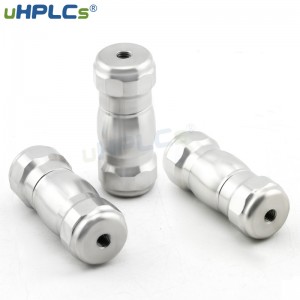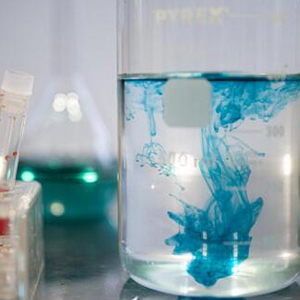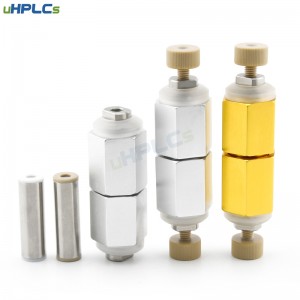While mass spectrometry coupled with liquid chromatography has proven to be a powerful tool in the field of discovery histology (proteomics, lipidomics, metabolomics, food histology, and glycomics), histological studies are often challenged by the complexity of the samples. Identifying and quantifying molecules of interest can be particularly difficult when working with small sample volumes and complex sample matrices (biofluids and single cell analysis). Miniaturization of liquid chromatography columns can overcome these challenges. Reducing the internal column diameter (ID) will reduce chromatographic dilution and increase sensitivity, resulting in more efficient MS/MS sampling and thus more molecular identification.
This dilution occurs when the sample volume is injected into the column and diluted by the surrounding solvent. In this case, less solvent means less chromatographic dilution, resulting from using a smaller inner column diameter. This reduction in chromatographic dilution leads to increased ion sensitivity, resulting in more efficient MS/MS sampling and thus more molecular identification. uHPLCs’s new 10×20 empty column tube assembly with a smaller inner diameter miniaturized liquid chromatography column allows for increased sensitivity.
In theory, reducing the column inner diameter from 2.1 mm to 0.300 mm results in a 49-fold increase in sample concentration, which translates into a 49-fold increase in sensitivity. In practice, this is not always the case, as sensitivity is measured by ionic strength, which depends on factors other than sample concentration, such as the ionization properties of the analyte and LC-MS equipment (emitter type) and source parameters.
Flow rates and sample loadings are used in liquid chromatography based on column type (ID).
|
Type |
HPLC Column (ID) |
Typical flow rate |
Typical sample load |
|
|
Nano Liquid Chromatography |
50-75 um |
200-500 L/min |
100-300 ng |
|
|
Micro Liquid Chromatography |
0.15-0.5 mm |
1.0-50 µL/min |
1-10μg |
|
|
Low flow analysis |
1.0-2.1 mm |
0.02-0.1 mL/min |
10-50μg |
|
|
Analytical |
2.1-8 mm |
0.1-3.0 mL/min |
0.1-1.5mg |
|
|
Semi-preparation |
9-15 mm |
5-10.0 mL/min |
1-10mg |
|
|
Preparation |
16-100 mm |
20-250 mL/min |
20-250 mg |
The combination of column miniaturization reducing chromatographic dilution and significantly improving ionization efficiency makes nano-flow a highly desirable technique in the Omics field when only a tiny amount of sample is available or due to the addition of non-volatile solvents or when better ionization is required. In addition to improved sensitivity, higher S/N (signal-to-noise ratio), and lower LLOQ (lower limit of quantification), it reduces solvent consumption, thus reducing costs and benefiting the environment. At the same time, as the flow rate decreases, the gradient length sometimes needs to be increased. The increase in gradient length decreases the sample throughput. Nevertheless, microfluidics is an excellent intermediate choice when sample throughput, sensitivity, and stability are required.
In addition, column clogging and overloading also need to be considered as micro solids, and in the case of proteomics, undigested proteins can clog small ID columns, making them unusable. Therefore, the user must carefully clean the sample before injection or use a trap (pre-column) column to eliminate undesired contaminants from reaching the small column. When using a trap column, the trap is aligned with the column, and the sample is loaded into it while unwanted particles are wasted. Once the sample is concentrated in the trap and free of contaminants, it is directed to the column for analysis. Using Henderson ghost peak trap columns helps avoid nano/micron column contamination and extends the column’s life. The ghost column can filter out contaminants in the organic phase, aqueous phase, buffer salts, mobile phase bottles, and contaminants from the mixing process.
Miniaturization of chromatographic columns brings many challenges, but the benefits undeniably outweigh them.5 Micro- and nano-flow separations bring new biomedical advances, and the gains in basic scientific knowledge make them a powerful analytical technique.
Post time: Jul-23-2022









